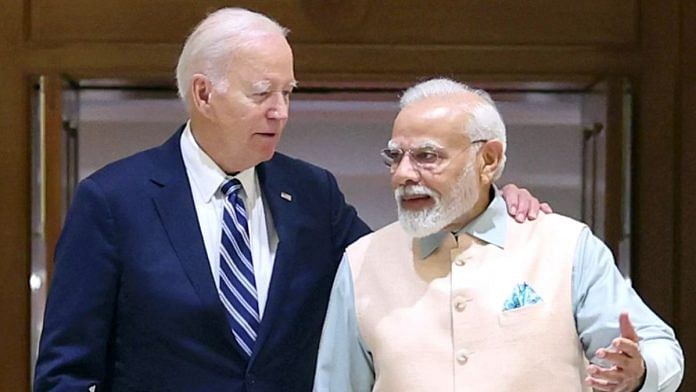China has a stranglehold on battery manufacturing. Its recent export control on graphite—a key battery material—indicates potential geopolitical-related supply chain disruptions. Given the boom in the battery market and China’s history of economic coercion, the US should cultivate supply chains in a reliable partner like India.
Batteries are also key for India as it plans to install 500 GW of renewable energy and meet 50 per cent of its electricity requirement from renewable energy sources by 2030. India’s success is crucial for global climate goals.
For India to become a battery manufacturing powerhouse, domestic reforms are crucial but not enough. American support must focus on minerals supply chains, financing, and technology cooperation.
Reliance on China
Battery demand is booming—in 2022, global electronic vehicle sales increased by 60 per cent, and storage systems sales increased by 100 per cent year-on-year. India aims to achieve 30 per cent electric vehicle sales penetration for cars, and 80 per cent for two-wheelers by 2030.
Batteries are also crucial for mitigating the variability of renewable energy installations. The government of India, cognisant of the importance of storage, released the “National Framework for Promoting Energy Storage Systems” indicating plans to install 230 GW of batteries by 2047.
Currently, India—like the rest of the world—relies on China to meet its battery demands: 88 per cent of the US lithium battery imports are from China.
Therein lies the problem.
China dominates the battery supply chain, manufacturing 75 per cent of all lithium-ion batteries, 90 per cent of all anodes, 70 per cent of cathodes, and over 80 per cent of electrolytes. At midstream, China processes virtually 100 per cent of graphite and 70 per cent of lithium—the materials composing anodes and cathodes, respectively.
For reference, the Organization of the Petroleum Exporting Countries (OPEC) supplied 35 per cent of the world’s crude oil in 2022.
As with the recent export restrictions on graphite, China can choke this supply at will to further its geopolitical ambitions, giving it immense power.
Therefore, it is critical for the United States and India to diversify supply chains.
Also read: China finds India’s semiconductor goals unrealistic. It is waiting for New Delhi to fail
US-India battery partnership
China has a massive first-off-the-block advantage and continues to make the right strategic investments for battery manufacturing. Simply put—China has been running the marathon longer and is also the fastest.
Ascertaining strategic places in the value chain to compete against China, like the Indian government’s recent semiconductor strategy focusing on compound semiconductors, is critical for success.
The US can support India in three ways—securing raw materials, financing, and technology cooperation.
In June 2023, the Ministry of Mines released a list of 30 critical minerals including battery minerals and partially privatised mineral exploration. While positive, starting extraction and processing is a lengthy and expensive process, which makes partners crucial.
India became a member of the Minerals Security Partnership in June 2023. However, this partnership currently focuses on environmental standards—raising non-tariff barriers for Chinese imports—rather than on supply chains. The nascency of the Minerals Security Partnership is a blessing in disguise. The US should involve Congo and Indonesia, which have critical mineral ores; and Japan and Korea, which have existing R&D capabilities.
Access to finance
Indian battery manufacturers face the challenge of creating a market, while simultaneously competing with Chinese scale manufacturing. India’s battery ambitions are expected to cost $40 billion by 2032. For reference, the combined spending on all climate projects in India in 2022 was $18 billion. The current $2.5 billion production linked incentive for batteries in 2021 isn’t enough.
A Critical Minerals Agreement (CMA) with the US can ensure that American manufacturers sourcing from India can access EV subsidies in section 30D of the Inflation Reduction Act, making Indian components’ price competitive.
However, negative reactions from US Congress after the US-Japan CMA necessitates involving them. The good news is that India has friends across the aisle. Additionally, the US recognises China’s stranglehold, and has introduced a minerals agreement involving India. However, there is a need to strengthen bipartisan support.
Also read: India can compete with China on semiconductors. But it needs to build investor trust first
Technology cooperation
There are promising new technologies that the US and India can jointly develop and test. For instance, Vanadium (recently discovered in India) redox flow batteries have a longer duration than lithium. Alternatively, with 100 GWh under development or installed in China, sodium ion batteries have commercial use cases.
Initiatives such as the Department of Energy-Ministry of New & Renewable Energy-led Strategic Clean Energy Partnership’s Energy Storage Taskforce, and the Renewable Energy Technology Action Platform, have potential. They can promote technical collaboration, and pilot testing. Additionally, leveraging India’s capabilities in research and development can support workforce skilling.
The US needs battery security as much as India does. Decoupling from China requires political will. With the United States’ support, India can become a global battery manufacturing hub, strengthening supply chains, and accelerating renewable energy goals.
Akshat Singh is a research associate with the Chair in U.S.-India Policy Studies at the
Center for Strategic and International Studies (CSIS). In this role, he works on promoting
U.S.-India commercial and economic engagements. Views are personal.
(Edited by Ratan Priya)



